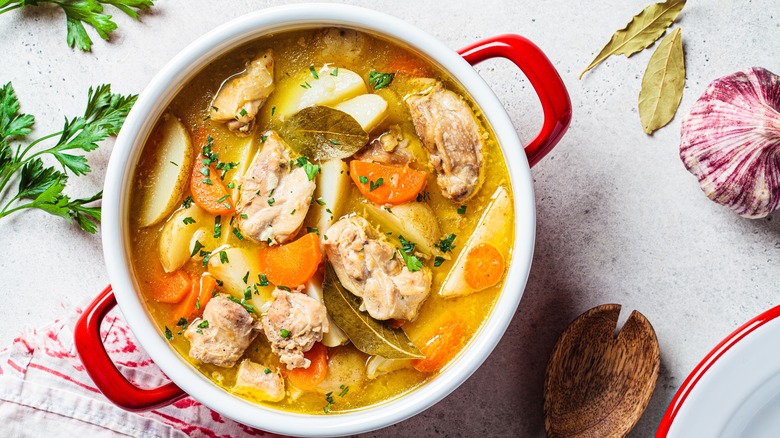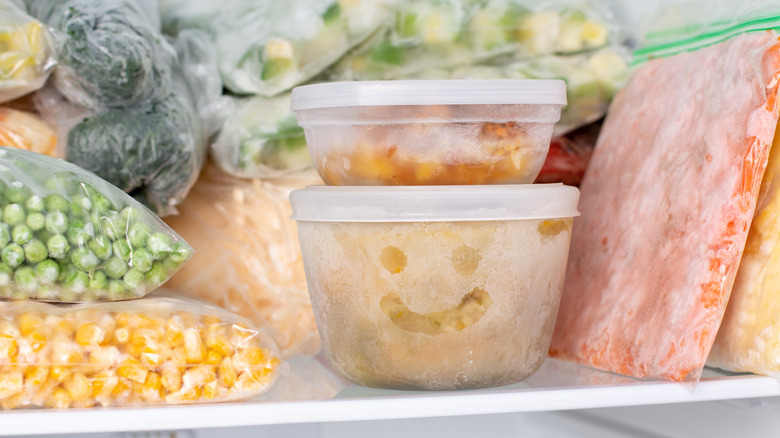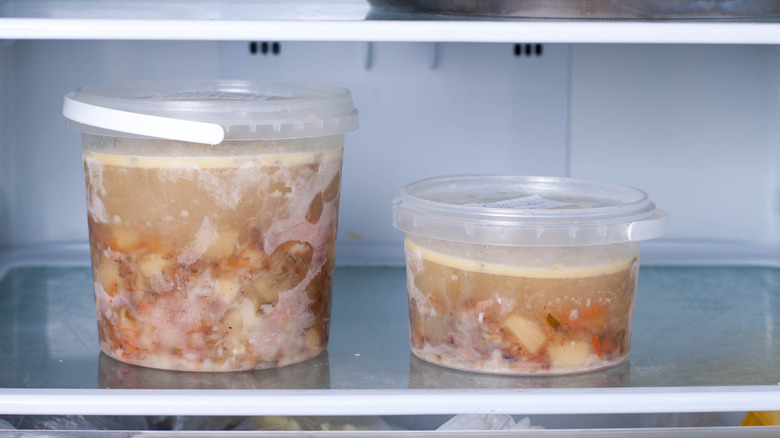The Messiest Mistake To Avoid When Prepping Soup To Freeze
The best part about soup? It's freezer-friendly, setting you up for success when a craving for comfort hits, a stubborn cold kicks in, or when you don't have the extra time to make a grocery store run. Whipping up a big batch turns into make-ahead magic, and stocking the freezer with future meals has never been easier. Although, how efficiently you store your soup can determine the outcome of your meal, and how clean your freezer stays.
Surprisingly enough, when ladling your soup into containers with the intention of freezing, the amount you place into each container can determine whether your soup will experience freezer burn, or cause a pesky freezer spill. That's right, the trick is to add the perfect amount so that each container is not under-filled, but also not packed too tight. An under-filled container exposes too much oxygen, yielding a freezer burn. On the contrary, because liquids expand when frozen, an over-filled container will cause a freezer spill that is less than pleasant to clean. Therefore, it's best to keep a few different shapes and sizes of containers on hand when it comes to freezing liquids.
Over-filling your containers
It happens to everyone — you're ladling your big batch of soup into containers and you don't want to waste a drop. You're working with a set number of Tupperware and they're filled to the brim, slightly leaking as you seal the lid on top. While you may think you're in the clear as long as the lids seal, think again, as liquids expand by 9% when frozen, on average. During this process, a liquid becomes a solid, causing the hydrogen bonds to shift into a lattice pattern that causes the water molecules to swell. When this occurs, your soup that is so strictly confined to its container has to go somewhere, and it's likely going to go onto your freezer shelves, leaking and causing a mess. There's nothing worse than a freezer spill, forcing you to remove everything and thaw each shelf just to break those stubborn bits free.
All in all, each container should have an inch of room left to breathe. If you've got an awkward amount of soup left, your options are to transfer it to a smaller container or toss it. While food waste is not ideal, it could save you from having to completely clean out your freezer, which leaves frozen foods at room temperature and runs the risk of bacteria growth, especially if it's re-frozen.
Under-filling your containers
When you've got an awkward amount of soup left, but only a large container to put it in, while you may think you're doing a good thing by reducing food waste, it's actually the perfect environment for freezer burn to occur. Freezer burn can be detected by frothy ice crystals that form on the outsides of food, and it's caused by your food being exposed to too much cold air, which allows the water molecules to escape and dry out certain spots of your food. From a health standpoint, while freezer burn may seem unsafe, it's actually perfectly fine to consume. The only downside is it dries your food out in certain areas, altering the texture and overall outcome of your soup once you've thawed it.
Investing in some smaller, freezer-friendly food storage containers is the best option to prevent this when sealing up your next batch of soup.


